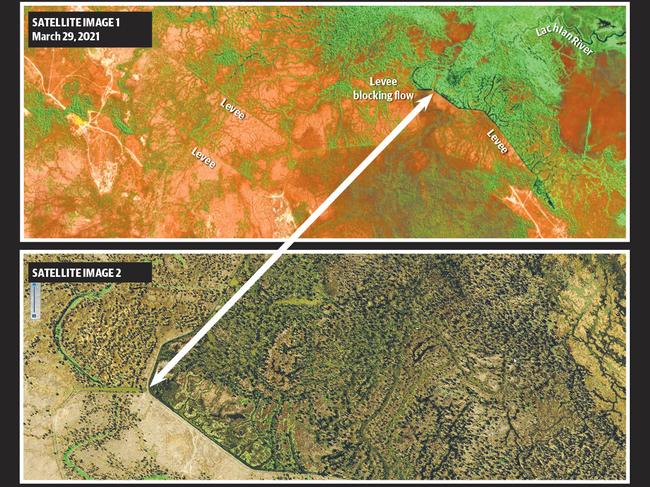The Nature Conservancy blocks Murray Darling Basin flows
Massive levees on an internationally-recognised environment group’s Riverina properties are blocking the Lachlan River’s flow. See the satellite images.

Massive levees on an internationally recognised environment group’s properties in the NSW Riverina are blocking the flow of one of the Murray Darling Basin’s key rivers.
Satellite images have revealed vast levees are preventing the Lachlan River’s flow as it tries to spread across one of Australia’s largest wetlands — the Great Cumbung Swamp — on the 33,765ha Juanbung and Boyong stations owned by The Nature Conservancy group.
The Nature Conservancy purchased the stations, near Maude, for $55 million in January 2019. At the time The Nature Conservancy water project officer Rene Woods — who now sits on the Murray Darling Basin Authority Board — stated water had its own identity and “should be able to flow where it wants”.
Almost three years on Sentinel satellite images show levee banks up to 9km long are still blocking the Lachlan River’s flow across the two stations, which are also used by The Nature Conservancy for cattle production in a joint venture with Tiverton Agriculture.
A huge channel that was dug straight across the Lachlan River in the early 1990s remains in place, diverting its flows to the west, while in the east another levee blocks water from flowing south to a vast wetland.
The levees’ impacts can clearly be seen on satellite images taken on March 29 this year, where they cut off wetland flows, causing a build-up of water (a dark blue line) boosting pasture and growth (bright green) in upstream zones for livestock, while the regions downstream of the levees remain dry (brown).
When asked why the levees had not been decommission after almost three years The Nature Conservancy spokeswoman said it: “has been working with the Commonwealth Environmental Water Office and NSW Department of Planning, Industry and Environment on ways to move to a more natural hydrological regime to the Great Cumbung (Swamp).
“These levees are a legacy of past ownership and not consistent with the intent for managing the property.”

The Weekly Times also asked if The Nature Conservancy’s focus was on watering the Lachlan River’s environmental assets or using the properties’ levees to hold back water to wet up pastures for livestock production. TNC responded by stating the focus was on “The environmental assets”.
“The nationally important reed bed has not been grazed since we purchased it and grazing on the rest of the property has been reduced from approximately 3000 head of cattle prior to purchase to less than 1000, with numbers averaging 400 during drier conditions.”
TNC also operates a red-gum mill on the properties, but its spokesman said they only used “dead material”.
TNC’s own website sates “some of Australia’s most respected investors and philanthropists are supporting TNC’s work in the Murray-Darling including John B. Fairfax AO, The Ian Potter Foundation, the Besen family and the Baillieu Myer family’s Yulgilbar Foundation.
Funding was also provided by the US-based Wyss Foundation and the Wyss Campaign for Nature.
TNC’s Australia Trust 2020 annual report states it jointly owns the two stations with the Tiverton Agriculture Impact Fund through The Great Cumbung Unit Trust.
Under the trust rules Tiverton can call on TNC to purchase their shares (put option) in the trust after August 23, 2023 or TNC may call on Tiverton to sell their shares in the trust after that date.
“Due to the significant impairment recognised in TGCUT during the period and the unlikely nature that the parties will remain in the investment for the long-term as a result, the group has assumed the exercise date for the put and call options is the date the lock-in period ends, being 23 August 2023,” the TNC 2020 annual report states.
The financials also show TNC made a $562,369 net gain on the sale of water rights in 2019-20 and received $448,000 in JobKeeper payments from the Federal Government, spending $8.18m of its $15.2m revenue on employee expenses.
Meanwhile NSW Government released its Review of 10 Southern Floodplain Management Plans this week, which found promised modification of levees had “not been implemented” to clear the flow of floodwater, while others had not even been identified and mapped.
The review found “nominated works (levees) obstruct the desired flow path, impacting environmental, cultural and potentially life and property outcomes” across the southern floodplains.
NSW Irrigators Council chief executive Claire Miller said “TNC needs to make good on its promise to remove these structures as soon as possible, to ensure the lower Lachlan wetlands get a proper drink”.
“This will only get more important with climate change, as wet years become fewer and further apart.”
Gwydir Valley Irrigators Association chief executive Zara Lowien said the NSW Natural Resources Access Regulator had already identified the need to deal with unapproved works on floodplains as a priority, in all Basin valleys.
“The NSW Government have a state-wide policy for floodplain management planning and licencing as well as an independent regulator in NRAR, they should learn from the lessons in the north and enforce their policy consistently around NSW,” Ms Lowien said.
“For this, they will need the support of the NSW Parliament to enable regulatory regime for floodplain harvesting licencing.”




